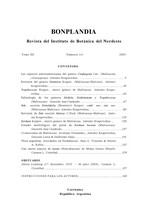POSICION TAXONOMICA, CITOLOGIA Y PALINOLOGIA DE TRES NIVELES DE PLOIDIA DE TURNERA SUBULATA SMITH
DOI:
https://doi.org/10.30972/bon.521-298292Resumen
Turnera subulata Sm. lives in America, from Panamá to Bolivia. It was introduced to Asia, where it is nowadays a common weed in India, Malasia and Indonesia.
Plant and pollen morphology, and citology were studied in one diploid (2n=2x=20) accessions of Turnera subulata from Brasil. One triploid hybrid (2n=15) was obtained by espontaneous Crossing of one tetraploid and the diploid strain.
In the literature there are counts of four accessions from Brasil, one from India and one from Malasia, all tetraploids (2n=20).
- subulata is considered a different species of T. ulmifolia be: cause it presents a certain combination of morphological characters, constant in all three ploidy levels.
Pollen sculpture is dimorphic, unlike other distylous taxa: short styled flowers have reticulate grains, with broad meshes and m any free bacules within; long styled flowers have small reticulate grains, with little meshes without free bacules. Pollen fertility is 96—99%in the diploid, 86—89% in the tetraploids and 48% in the triploid.
Meiotic chromosome behavior was regular in the diploid acces- sion with 5 bivalents in every pollen mother cell (PMC). Meiosis was also studied in two tetraploid accessions, which showed a high level of quadrivalent chromosome associations. The máximum of five qua- drivalents was observed in 15 and 35 percent of the PMC respectively. Three different chromosome configurations were observed in the triploid hybrid at metaphase I: 5 III in 29,5% of the PMC’ s, 4 III + 1 II + 1 I in 45,9%, and 3 III + 2 II +21 in 24,5%. These findings sug- gest that the 2n=20 cytotypes are autotetraploids.
Tumera subulata 2n=10 and its autotetraploid derivates 2n = 20 constitute only one species beeause there is genetic continüity among them.
Descargas
Citas
Backer, C.A. 1951. Turneraceae. Flora Malesiana Ser. I, 4: 235—238.
Backer, C.A. & Bakhuizen van den Brink, R.C. 1963. Turneraceae . Flora of Java 1: 179-180.
Ball, N.G. 1933. A physiological investigaron of the ephemeral flo- wers of Turnera ulmifolia L. var. elegans Urban. New Phytol. 32: 13-36.
Barret, S. C. H. 1978. Heterostyly in a tropical weed: the reproducti- ve biology of the Turnera ulmifoüa complex (Turneraceae). Canadian J. Bot. 56 (15): 1713-1725.
Barret, S. C. H. & Shore, J. 1980. Variation in breeding systems in the Turnera ulmifolia complex. Trabajo presentado en el Second International Congress of Systematic and Evolutionaiy Biology, Yancouver, Canadá.
Bentley, B. L. 1979. Heterostyly in Turnera trioniflora, a roadside weed of the Amazon basin. Biotropica 11 (1): 11—17.
Brizicky, G. K. 1961. The genera of Turneraceae and Passifloraceae in the Southeastern United States. J. Arnold Arbor. Harv. Univ. 42: 204-218.
Hamel, J.L. 1965. Le noyau et les chromosomes somatiques de Turnera ulmifolia L. Mém. Mus. Nat. Hist. Nat. Sér.B, 16 (1): 3—8.
Hutchinson, J. & Dalziel, J.M. 1954. Turneraceae. Flora of West Tropical Africa 2nd. ed. Millbank, London. 1: 85.
Lewis, Harían et al. 1951. Chromosome numbers of Californian Del- phiniums and their geographical occurrence. Ann. Missouri Bot. Gard. 38: 101-117.
Lewis, Harían 1967. The taxonomic significance of autopoliploidy. Taxon 16: 267—271;
Lock, R. H. 1904. Ecological notes on Turnera ulmifolia L. var. ele - gans Urban. Ann. R. Bot. Gard. Perad. 2: 107—119-
Pittier, H. et al. 1947. Turneraceae. Catálogo de la Flora Venezolana. Caracas. 2: 171.
Raman, V. S. & Kesavan, P. C. 1964. Meiosis and the nature of poly- ploidy in Turnera ulmifolia. J. Indian Bot. Soc. 43: 495—497.
Ridley, H. N. 1922. Turneraceae. The Flora of the Malay Península. 1:838.
Rodrigues, W. A- 1967. Inventario florestal preliminar de una mata da regiao do Araras, Rio Negro., Estado do Amazonas. Anais XV Congresso Soc. Bot. Brasil-, Porto Alegre, 1964. 1: 297—367.
Stebbins, G. L. 1951. Variation and evolution in plants. 2nd. ed. Co- lumbia Univ. Press. New York.
Urban, I. 1883. Monographie der Familie der Turneraceen. Jalirb. Ko- nigl. Bot. Gart. Mus. Berlín 2: 1—152.
Descargas
Publicado
Cómo citar
Número
Sección
Licencia
Derechos de autor 2025 Bonplandia

Esta obra está bajo una licencia internacional Creative Commons Atribución 4.0.
Declaration of Adhesion to Open Access
- All contents of Bonplandia journal are available online, open to all and for free, before they are printed.
Copyright Notice
- Bonplandia magazine allows authors to retain their copyright without restrictions.
- The journal is under a Creative Commons Attribution 4.0 International license.















.jpg)


